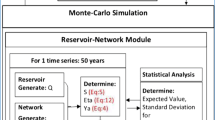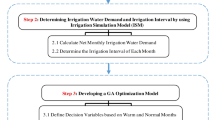Abstract
This paper develops a non-linear programming optimization model with an integrated soil water balance, to determine the optimal reservoir release policies, the irrigation allocation to multiple crops and the optimal cropping pattern in irrigated agriculture. Decision variables are the cultivated area and the water allocated to each crop. The objective function of the model maximizes the total farm income, which is based on crop–water production functions, production cost and crop prices. The proposed model is solved using the simulated annealing (SA) global optimization stochastic search algorithm in combination with the stochastic gradient descent algorithm. The rainfall, evapotranspiration and inflow are considered to be stochastic and the model is run for expected values of the above parameters corresponding to different probability of exceedence. By combining various probability levels of rainfall, evapotranspiration and inflow, four weather conditions are distinguished. The model takes into account an irrigation time interval in each growth stage and gives the optimal distribution of area, the water to each crop and the total farm income. The outputs of this model were compared with the results obtained from the model in which the only decision variables are cultivated areas. The model was applied on data from a planned reservoir on the Havrias River in Northern Greece, is sufficiently general and has great potential to be applicable as a decision support tool for cropping patterns of an irrigated area and irrigation scheduling.








Similar content being viewed by others
References
Allen RG, Pereira LS, Raes D, Smith M (1998) Crop evapotranspiration: guidelines for computing crop water requirements. Irrigation and drainage paper, no 56
Arnold CD, Elliot WJ (1996) CLIGEN weather generator predictions of seasonal wet and dry spells in Uganda. T ASAE 39:969–972
Azencott R (1992) Simulated annealing parallelization techniques. Wiley, USA
Bogardi JJ, Duckstein L, Rumambo OH (1988) Practical generation of synthetic rainfall event time series in a semi-arid climatic zone. J Hydrol 103:357–373
Borg H, Grimes DW (1986) Depth development of roots with time: an empirical description. T ASAE 29:194–197
Bos MG, Vos J, Feddes RA (1996) CRIWAR 2.0 A simulation model on crop irrigation water requirements. ILRI Publication No 46, Wageningen
Box GEP, Jenkins GM (1976) Time series analysis: forecasting and control. Revised edn. Holden Day, San Francisco, 532 pp
Bras RL, Rodriguez-Iturbe L (1993) Random function and hydrology. Dover, New York
Cunha MC, Sousa J (1999) Water distribution network design optimization: simulated annealing approach. J Water Resour Planning Manage ASCE 125:215–221
Dagpunar J (1988) Principles of random variate generation. Oxford Science Publications, Oxford
de Bruin HAR (1978) A simple model for shallow lake evaporation. J Appl Meteor 17:1132–1134
Doorenbos J, Kassam AH (1979) Yield response to water. Irrigation and drainage paper, no 33
Dougherty DE, Marryott RA (1991) Optimal ground water management. 1. Simulated annealing. Water Resour Res 27:2493–2508
Floudas CA, Pardalos PM, Adjiman CS, Esposito WR, Gumus ZH, Harding ST, Klepeis JL, Meyer CA, Schweiger CA (1999) Handbook in test problems in local and global optimization. Kluwer, Dordrecht
Ganji A, Ponnambalam K, Khalili D, Karamouz M (2006) A new stochastic optimization model for deficit irrigation. Irrig Sci 25:63–73
Georgiou PE (2004) Optimal reservoir operation for irrigation purposes. Ph.D. dissertation, Aristotle University of Thessaloniki, Greece (in Greek)
Georgiou PE, Papamichail DM, Vougioukas SG (2006) Optimal irrigation reservoir operation and simultaneous multi-crop cultivation area selection using simulated annealing. Irrig Drain 55:129–144
Ghahraman B, Sepaskhah AR (2002) Optimal allocation of water from a single reservoir to an irrigation project with pre-determined multiple cropping patterns. Irrig Sci 21:127–137
Ghahraman B, Sepaskhah AR (2004) Linear and non-linear optimization models for allocation of a limited water supply. Irrig Drain 53:39–54
Hanson CL, Cumming KA, Woolhiser DA, Richardson CW (1997) Microcomputer program for daily weather simulation in the contiguous United States. USDA, Agriculture Research Service
Hipel KW, McLeod AI (1994) Time series modelling of water resources and environmental systems. Developments in Water Science, no 45. Elsevier, Amsterdam
Hutchinson MF, Ungani LS (1991) The effect on rainfall frequencies of changes in mean annual and monthly rainfalls. In: SADCC land and water management research programme. Proceedings of 2nd annual scientific conference, Mbabane, pp 42–55
Jensen ME (1968) Water consumption by agricultural plants. In: Kozlowski TT (ed) Water deficits and plants growth, vol II. Academic Press, New York, pp 1–22
Kipkorir EC, Raes D (2002) Transformation of yield response factor into Jensen’s sensitivity index. Irrig Drain Syst 16:47–52
Kipkorir EC, Sahli A, Raes D (2002) MIOS: a decision tool for determination of optimal irrigated cropping pattern of a multicrop system under water scarcity constraints. Irrig Drain 51(2):155–166
Kirkpatrick S, Gelatt CD, Vecchi MP (1983) Optimization by simulated annealing. Sci 220:671–680
Kotsopoulos SI (1989) On the evaluation of risk of failure in irrigation water delivery. Ph.D. thesis, Southampton
Kotsopoulos SI, Svehlik ZJ (1989) Analysis and synthesis of seasonality and variability of daily potential evapotranspiration. Water Resour Manage 3:259–269
Kuo JT, Hsu NS, Chu WS, Wan S, Lin YJ (1990) Real-time operation of Tanshui river reservoirs. J Water Resour Planning Manage ASCE 116:349–361
Kuo CH, Michel AN, Gray GW (1992) Design of optimal pump and treat strategies for contaminated groundwater remediation using the simulated annealing algorithm. Adv Water Resour 15:95–105
Labadie JW (2004) Optimal operation of multireservoir systems: state-of-the-art review. J Water Resour Plann Manage 130:93–111
Lindo Systems Inc. (2003) Optimization modeling with LINGO. USA
Makridakis S, Wheelwright SC, Hyndman RJ (1998) Forecasting: methods and applications, 3rd edn. Wiley, New York
Matalas NC (1967) Mathematical assessment of synthetic hydrology. Water Resour Res 3:937–945
Mathworks (2003) MATLAB The language of technical computing. USA
Metropolis N, Rosenbluth AW, Rosenbluth MN, Teller AH, Teller E (1953) Equation of state calculation by fast computing machines. J Chem Phys 21:1087–1091
Monem MJ, Namdarian R (2005) Application of simulated annealing (SA) techniques for optimal water distribution in irrigation canals. Irrig Drain 54:365–373
Nelson R (2002) ClimGen—climate data generator User’s Manual. Washington State University
Nicks AD, Harp JF (1980) Stochastic generation of temperature and solar radiation data. J Hydrol 48:1–17
Papamichail DM, Georgiou PE (2001) Seasonal ARIMA inflow models for reservoir sizing. J Am Water Resour Assoc 37:877–885
Pardo-Iguzquiza E (1998) Optimal selection of number and location of rainfall gauges for areal rainfall estimation using geostatistics and simulated annealing. J Hydrol 210:206–220
Press WH, Teukolsky SA, Vetterling WT, Flannery BP (1992) Numerical recipes in fortran, 2nd edn. Cambridge University Press, Cambridge
Priestley CHB, Taylor RJ (1972) On the assessment of surface heat flux and evaporation using large-scale parameters. Mon Weather Rev 100:81–92
Raes D (2002) BUDGET: a soil water and salt balance model. Reference manual, Version 5.0, K.U. Leuven
Raes D, Sahli A, Van Looij J, Ben Mechlia N, Persoons E (2000) Charts for guiding irrigation in real time. Irrig Drain Syst 14:343–352
Rao NH, Sarma PBS, Chander S (1988) A simple dated water-production function for use in irrigated agriculture. Agric Water Manage 13:25–32
Rao NH, Sarma PBS, Chander S (1990) Optimal multicrop allocation of seasonal and intraseasonal irrigation water. Water Resour Res 26:551–559
Region of Central Macedonia, 2002. Structural agricultural policy. Region of Central Macedonia, Thessaloniki, Greece (in Greek)
Richardson CW (1981) Stochastic simulation of daily precipitation, temperature, and solar radiation. Water Resour Res 17:182–190
Rizzo DM, Dougherty DE (1996) Design optimization for multiple management period groundwater remediation. Water Resour Res 32:2549–2561
Sabu P, Sudhindra PN, Kumar ND (2000) Optimal irrigation allocation: a multilevel approach. J Irrig Drain Eng ASCE 126:149–156
Shangguan Z, Shao M, Horton R, Lei T, Qin L, Ma J (2002) A model for regional optimal allocation of irrigation water resources under deficit irrigation and its applications. Agric Water Manage 52:139–154
Steenhuis TS, Van Der Molen WH (1986) The Thorthwaite–Mather procedure as a simple engineering method to predict recharge. J Hydrol 84:221–229
Stewart JR, Hagan RM (1974) Functions to predict optimal irrigations programs. J Irrig Drain Div ASCE 100:179–199
Stewart JR, Misra RD, Pruitt WO (1975) Irrigation of corn and grain sorghum with a deficient water supply. T ASAE 18:270–280
Stewart JI, Cuenca RH, Pruitt WO, Hagan RM, Tosso J (1977) Determination and utilization of water production functions for principal California crops. W-67 Calif. Contrib. Proj. Rep. University of California, Davis
Teegavarapu RV, Simonovic SP (2002) Optimal operation of reservoir systems using simulated annealing. Water Resour Manage 16:401–428
Thomas HA, Fiering MB (1962) Mathematical synthesis of streamflow sequences for the analysis of river basins by simulation. Design of water resources systems, Chap. 12, Harvard University Press, Cambridge
Tsakiris G (1982) A method for applying crop sensitivity factors in irrigation scheduling. Agric Water Manage 5:335–343
Tsakiris G (1988) Daily potential evapotranspiration. Agric Water Manage 13:393–402
USDA Soil Conservation Service (1993) Irrigation water requirements. National engineering handbook, Part 623, Chap 2
Vardavas IM, Fountoulakis A (1996) Estimation of lake evaporation from standard meteorological measurements: application to four Australian lakes in different climatic regions. Ecol Mod 84:139–150
Vedula S, Kumar ND (1996) An integrated model for optimal reservoir operation for irrigation of multiple crops. Water Resour Res 32:1101–1108
Vedula S, Mujumdar PP (1992) Optimal reservoir operation for irrigation multiple crops. Water Resour Res 28:1–9
Vedula S, Mujumdar PP, Sekhar GC (2005) Conjunctive use modeling for multiple irrigation. Agric Water Manage 73:193–221
Vougioukas S (1999) Path planning based on accelerated simulating annealing in artificial potential field. In: “Modern applied mathematics techniques in circuits. Systems and control. World Scientific Engineering, Athens pp 323–331
Wardlaw R, Barnes J (1999) Optimal allocation of irrigation water supplies in real time. J Irrig Drain Eng ASCE 125:345–354
Webster JG (2001) Stochastic optimization, stochastic approximation and simulated annealing. Wiley Encycl Elec Electron Eng 20:529–542
Winston V (2003) Introduction to mathematical programming, 4th edn. Thomson-Brooks/Cole, USA
Yeh WWG (1985) Reservoir management and operations models: a state of the art review. Water Resour Res 21(12):1797–1818
Young MDB (2002) Development and application of PARCHED-THIRST: a user-friendly agrohydrological model for dry land cropping system. Ph.D. thesis, Newcastle Upon Tyne, University of Newcastle Upon Tyne
Young MDB, Gowing JW (1996) The PARCHED-THIRST model—user guide (Version 1.0). University of Newcastle Upon Tyne, UK
Author information
Authors and Affiliations
Corresponding author
Additional information
Communicated by A. Kassam.
Rights and permissions
About this article
Cite this article
Georgiou, P.E., Papamichail, D.M. Optimization model of an irrigation reservoir for water allocation and crop planning under various weather conditions. Irrig Sci 26, 487–504 (2008). https://doi.org/10.1007/s00271-008-0110-7
Received:
Accepted:
Published:
Issue Date:
DOI: https://doi.org/10.1007/s00271-008-0110-7




